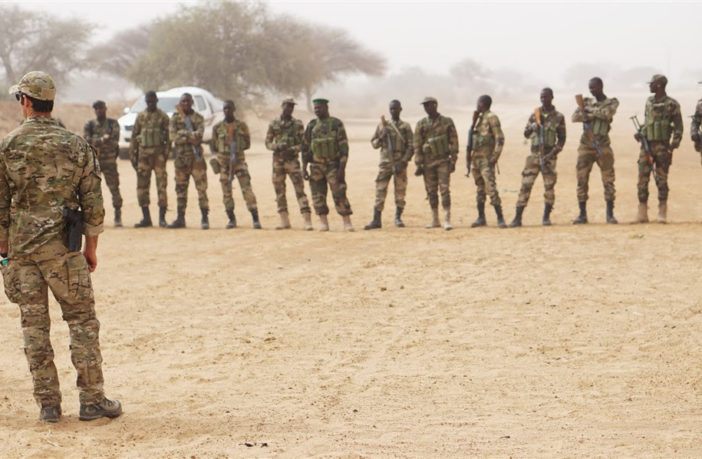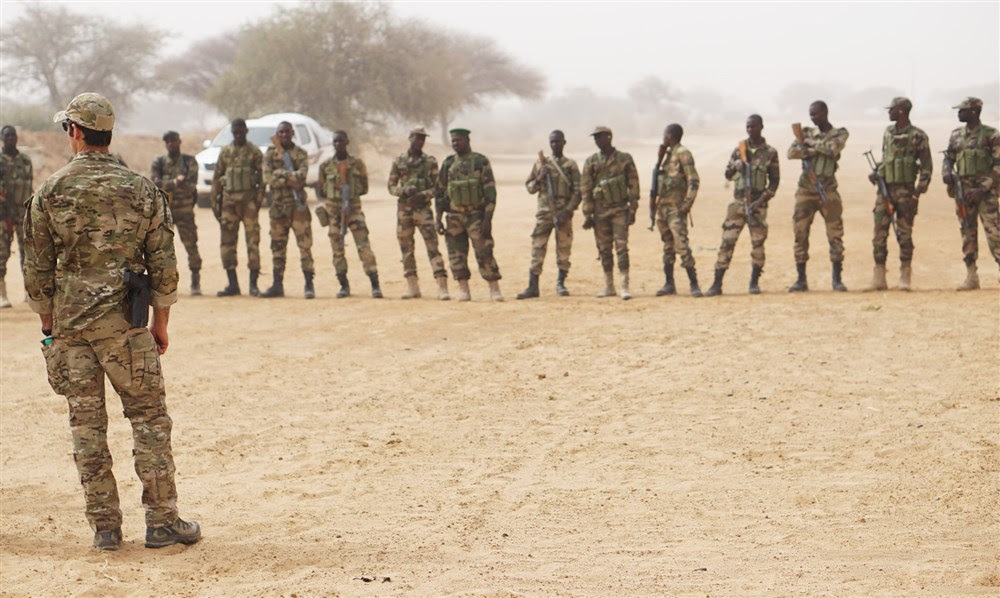Lawfare Blog
AUMF
By Robert Chesney
[Update: Several people reached out after I posted last night, drawing attention to the fact that al-Mourabitoun (also spelled al Murabitun) apparently reunited with AQIM after its initial separation from the group.
On the other hand, others reached out to point to indications that the particular leader at the center of the current storm—al Sahraoui—may still lead a splinter faction that resisted/resists the return to the AQIM fold. All of which underscores the fluidity and uncertainty that tends to plague efforts to draw sharp and steady organizational boundaries in the context of such networks, and that in turn underscores the complexity of defining the organizational scope of the AUMF (and the underlying claim of armed conflict. For some helpful insights, see here, here, and here.).
Will Niger soon join the ranks of Afghanistan, Pakistan, Iraq, Syria, Yemen, Somalia and Libya as locations in which the U.S. government is using lethal force for counterterrorism purposes under color of the law of armed conflict and the 2001 AUMF? This report from NBC (Ken Dilanian, Courtney Kube, William Arkin and Hans Nichols) says the answer is yes, based on disclosures from three unnamed U.S. officials. Here are some of the legal questions to bear in mind as this story develops:
1. Would the geographic novelty of using force in Niger, standing alone, be a significant departure from Obama administration legal and policy positions, or would it simply be (for better or worse) an application of those same positions to an evolving factual circumstance?
The U.S. government has not used lethal force in Niger previously, so far as the public record indicates (though it is quite easy to imagine that we have provided significant support to local and French partners who have done so). This may now change. Does that mean that the Trump administration is breaking with the Obama administration’s legal or policy framework? I don’t think so. Obama administration officials were at pains for many years to insist that they took the view—like the Bush administration before it—that the United States was engaged in a genuine armed conflict with al Qaeda, the Taliban, and their associated forces (including the Islamic State on the ground that it was simply AQI under a new name)—and that this conflict had no geographic boundary whatsoever. This is one reason why the Obama administration did not hesitate to begin using airstrikes on a sustained basis in Libya against Islamic State targets in 2016, notwithstanding the novelty of that geographic expansion. From that point of view, there’s nothing necessarily novel about the Trump administration now determining that a similar development has now arisen in Niger.
2. Does that mean the U.S. government claims it can use force under color of the law of war in any other country wishes?
No. The Obama administration took the view that geographic legal constraints flowed not from the law of armed conflict or the AUMF but, instead, from the UN Charter and Article 2(4). The NBC News story suggests that the Trump administration feels the same way (rather remarkably):
In the wake of the attack, the U.S. has been pressing the government of Niger to allow armed drones at the U.S. bases in that country, three U.S. officials said.
Of course, it could be that this request for Niger’s permission flows solely from diplomaticconsiderations, and not from a felt legalobligation. Or maybe it is no more and no less than a practical by-product of the geographic challenges of operating in that region, which might dictate reliance on bases in Niger’s territory. But barring evidence to the contrary, there’s no basis at this point to assume the Trump administration has broken with this traditional understanding of Article 2(4)’s relevance.
3. Maybe…but there’s more than geographic novelty in play here. What about organizational novelty?
It seems to me that this is the more significant issue: Would armed operations in Niger involve a fresh organizational extension of the AUMF (and the associated armed-conflict claim)? It would hardly be the first such extension if so. But with each extension, the credibility of the claim that the 2001 AUMF provides all requisite domestic law authority grows more tenuous (and, by the same token, claims about the existence of a relevant conflict become more complicated). That does not mean this particular extension would be a bridge too far, but it does mean that this development would add still more weight to the already-strong case for Congress to revisit the 2001 AUMF.
At any rate, let’s wrap up with a quick look at who the enemy in Mali actually seems to be. Another NBC report provides some very helpful context (I’m going to quote from it extensively since the nuances are complicated, trusting that this will not dissuade you from also reading the underlying piece):
The primary target of [the current French and US missions in the region] is a terrorist organization based in Mali and Libya known as Al-Mourabitoun.
Al-Mourabitoun isn’t well known by the American public or policymakers, but the group and its affiliates have an extensive history of activity across West Africa and the Sahara. Al-Mourabitoun has been tied to a string of deadly attacks that have killed hundreds since the group’s formation in 2013.
…The target of the intelligence activity was the immediate circle of leadership surrounding a militant named Adnan Abu Walid al-Sahraoui, a veteran insurgent originally from Laayoune in Western Sahara, according to two sources….
Al-Sahraoui is affiliated with the insurgent group Al-Mourabitoun, which was led for many years by Mokhtar Belmokhtar…
Al-Mourabitoun — or at least one of its affiliate brigades — now appears to be led by al-Sahraoui, who on May 14, 2015, released an audio message pledging allegiance to ISIS. Several days later, Belmokhtar issued a message rejecting this pledge and affirming the group’s loyalty to Al Qaeda. However, Belmokhtar was reported dead in an apparent U.S. airstrike a month later, but the group has not acknowledged that he was killed and there is no way to independently confirm his fate.
ISIS publicly accepted al-Sahraoui’s pledge of allegiance in 2016.
Because of the varying accounts of who is in charge of Al-Mourabitoun, and precisely what its goals and loyalties are, the subgroup operated by al-Sahraoui is sometimes referred to by other names: One of these is the Islamic State of the Greater Sahel, abbreviated ISGS — or sometimes ISIS-GS.
4. So…is al-Mourabitoun within the scope of the AUMF?
In the summer of 2015, I analyzed the relevance of the 2001 AUMF to the airstrike on Belmokhtarmentioned above. I noted that Belmokhtar had been part of the Algerian jihadist groups GIA and GSPC, that GSPC later affiliated with al Qaeda to become AQIM), and that Belmokhtar eventually led a splinter group away from AQIM but seemed to maintain his own ties directly to al Qaeda’s core leadership. Now we layer in the possible further-splintering of Belmokhtar’s group, with an offshoot (al-Mourabitoun) that is active in Niger and that has announced an affiliation with the Islamic State.
Does the 2001 AUMF apply?
If you think that there should be no “associated forces” concept under the AUMF, then of course the answer would be no.
If you believe there is an “associated forces” concept, but think that the Islamic State (as the former AQI) at some point dropped out of that category before hostilities with the United States resumed, then the answer would be no.
If you believe that there is an “associated forces” concept, and that the Islamic State (as the former AQI) never ceased to be covered under the AUMF, then the remaining questions are whether (i) there can be associated forces of associated forces; (ii) al-Mourabitoun really is an Islamic State associated force; and (iii) whether al-Mourabitoun has taken any required step to show that it is not just an associated force in general but also one that has engaged in hostilities against the United States. The ambush should resolve that third prong of the analysis, and I’m not aware of any reason to doubt the second one. It seems to me, then, that the issue turns entirely on the original status of the Islamic State plus the idea of an associated-force daisy chain.
5. If the AUMF does not faily extend to al-Mourabitoun, is that the end of the analysis from a domestic law perspective?
No. Do not overlook the possibility that the administration would argue that Article II self-defense authorities come into play with respect to al-Mourabitoun, quite apart from the AUMF, now that the ambush has occurred (and in light of the prospect that there is good reason to believe the al-Mourabitoun is actively and capably looking to kill more Americans in Niger if possible). As longtime readers may recall, my view on the critical-but-overlooked Article II fallback argument are set forth in my paper “Postwar,” available here.

Bobby Chesney is the Charles I. Francis Professor in Law and Associate Dean for Academic Affairs at the University of Texas School of Law. He also serves as the Director of UT-Austin’s interdisciplinary research center the Robert S. Strauss Center for International Security and Law. His scholarship encompasses a wide range of issues relating to national security and the law, including detention, targeting, prosecution, covert action, and the state secrets privilege; most of it is posted here. Along with








